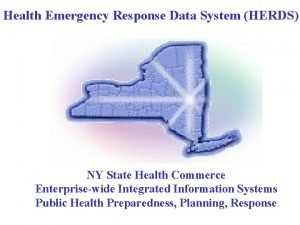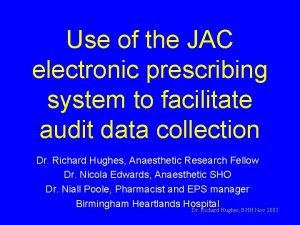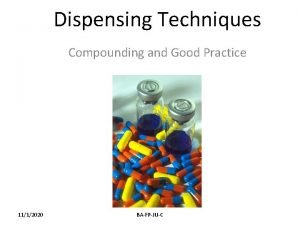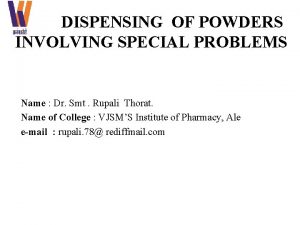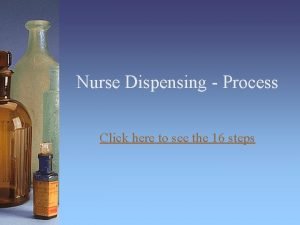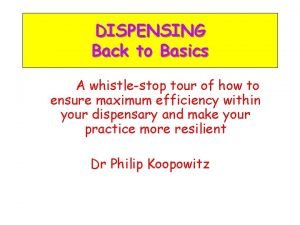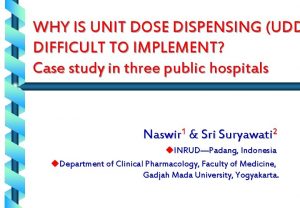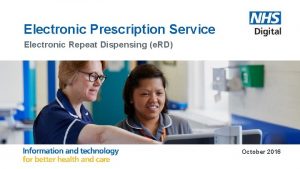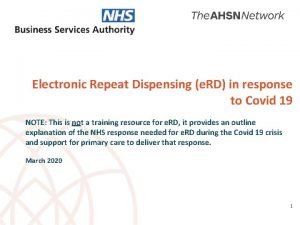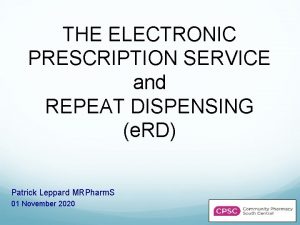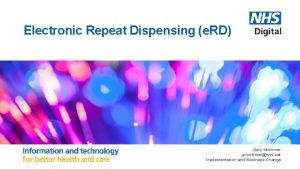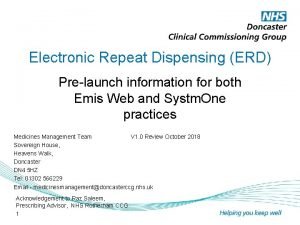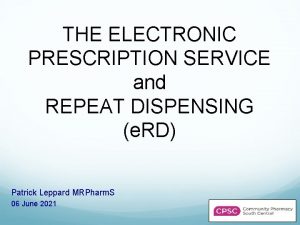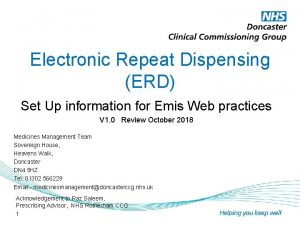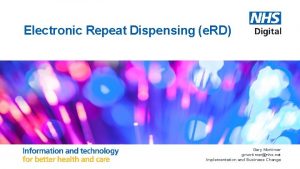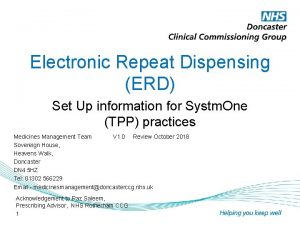Electronic Repeat Dispensing e RD in response to













- Slides: 13

Electronic Repeat Dispensing (e. RD) in response to Covid 19 NOTE: This is not a training resource for e. RD, it provides an outline explanation of the NHS response needed for e. RD during the Covid 19 crisis and support for primary care to deliver that response. March 2020 1

Contents 1 | Background 2 | Benefits (in response to Covid 19) 3 | e. RD levels in England 4 | Support 5 | Resources 2

1. Background – e. RD is not new, it has been part of the Community Pharmacy contract since 2005 and from 2019 has been a GMS contract requirement. e. RD has a number of well documented benefits for primary care. However, uptake of e. RD is hugely variable – see slides 5, 6 and 7 77% of all prescription items are repeat prescriptions. On average, each week, a GP issues around 375 repeat medicines. Department of Health work in 2002 showed that, if 80% of all repeats were given as RD, 2. 7 million GP hours would be saved. For example, in Wessex this means that if we moved 80% of all repeats to e. RD we would save 108, 000 GP hours, which is roughly 61 WTE GPs. 3

2. Benefits of e. RD in response to Covid 19 As part of the Primary Care response to Covid 19, NHS England have stated: "General practices have been asked to consider putting all suitable patients on electronic repeat dispensing as their next repeat prescriptions are issued. The whole repeatable prescription can be valid for a year, but each repeat should be for no longer than the patient has now. For example, if the patient has prescriptions for a month’s supply now, then the repeat dispensing should be set up as 13 x 28 days supply. ” Increasing e. RD will have the following benefits in the current situation: ü Reducing footfall to the GP practice and to the community pharmacy, supporting social distancing. ü Reducing workload for prescribers allowing better prioritisation of resources ü Controlled management of the supply chain reducing the number of temporarily unavailable medicines. Where e. RD has been championed for repeat prescribing, practices have successfully achieved over 70% of patients receiving their medications in this way. Early findings from a qualitative study in Wessex also indicate that patient experience with e. RD is a good one. 4

3. EPS - Variation across the country As at Dec 19 135 of 191 CCGs are below 80% EPS utilisation Range of EPS use across CCGs was 37. 74% to 96. 61% As at Dec 19 393 GP practices were not using EPS But highest utilisation was 100% 5

3. e. RD – Variation across the country As at Dec 19 CCGs use of e. RD ranged from 0% to 47. 7% As at Dec 19 1834 GP Practices had zero e. RD utilisation Highest utilisation was 87. 5% 6

H RT T EA S & R BE CU M IA BR K OR NE RS AN D W NE T H RT NO ON AT I PA RT GL HU M RD FO OX T X SE W ES ES W H EX SS SU ST ER N SN AH AH SN AH AH SN N AH S SN AH S N HS SN AH SA N ER ST HE EN & OF E & UT EY EN CY N HS SA LA ND EA AN C UC L T AG ID M SO HI R ES W M RR SU NO V IN e. RD Items as Pct of EPS Items NO H LT HE A e. RD Items as Pct of Total Items KS YO R KE ON TI VA IN NO NT TH AL HE T ES N AN D ID L M AT IO W NO V IN ST EA 3. e. RD by AHSN (note within this there will be significant variation at CCG and Practice level) e. RD by AHSN Oct - Dec 19 35, 00 30, 00 25, 00 20, 00 15, 00 10, 00 5, 00 0, 00 7

4. Support for GP practices and Community Pharmacies There a range of resources already available to support implementation See slide 13. No one should need to write further guidance on e. RD. Identification of suitable patients - NHS BSA now have the ability to support GP practices by providing them with the NHS numbers of patients who have had the same medicines dispensed to them for the last 12 months. This will be released to practices in stages and the following slides describe the process that the NHS BSA will use. NHS BSA are able to provide further support and signposting to practices that contact them. CCGs embarking on moving patients to e. RD MUST discuss plans with their Local Pharmaceutical Committee (LPC) prior to switching. Practices moving to e. RD must discuss their plans with local community pharmacies. 8

NHS BSA Process to provide GP Practices with NHS numbers of patients suitable for electronic repeat dispensing 1. To help support the response to Covid-19, NHS Business Services Authority (NHSBSA) will introduce a new streamlined service for GP practices to receive NHS Numbers for patients who may be eligible for Electronic Repeat Dispensing (e. RD). 2. NHSBSA will contact every GP practice for whom we have contact details, to confirm whether they have an active nhs. net email address. NHSBSA will only send NHS numbers to nhs. net email addresses. 3. Once confirmed, NHSBSA will send the practice an email with a file containing the following information for patients within the criteria specified on slide 12 that are potentially eligible for e. RD: – NHS Number – Name of item prescribed (dm+d, Virtual Medicinal Product and described generically ) 4. Once the practice has received the NHS Numbers, a clinician should review the patient records of those patients to ensure that they are appropriate for e. RD. 5. The practice should then arrange for verified patients to be moved to e. RD. – NHSBSA can provide materials and guidance to support moving appropriate patients to e. RD. NB This will only include EPS prescriptions 9

How are patients identified for e. RD? NHSBSA will apply the following criteria to identify which patients may be eligible for e. RD Patient identifier Description Patients on single medication for last 12 months Patients on a single unchanged medication for last 12 months on EPS Patients on two medications for the last 12 months Patients have been included on the basis that they have received at least 12 prescriptions for the same two medications, in the 12 month period specified. Patients may have received more than one prescription in any given month, so there may be gaps in any individual patient's prescribing history. Patients on three medications for the last 12 Patients have been included on the basis that they have months received at least 12 prescriptions for the same three medications, in the 12 month period specified. Patients may have received more than one prescription in any given month, so there may be gaps in any individual patient's prescribing history. Data currently excludes: patients aged 18 or under Appliances Personally administered drugs and medicines (PADMs) Dispensing Doctors Controlled Drugs FP 10 MDA 10

NHS BSA Process to provide GP Practices with NHS numbers of patients suitable for electronic repeat dispensing NHSBSA contacts all GP practices (where email addresses are available) Does the practice respond to confirm email address? Yes NHSBSA review EPS and e. RD data for the practice NHSBSA send the GP practice NHS Numbers for patients who are potentially eligible for e. RD. Yes Does practice have prior experience of e. RD or EPS levels of above 60%? • • No End No Key Points • All NHS Numbers must be clinically reviewed to ensure that it is clinically appropriate for that patient to move to e. RD. • It is vital for the medicines supply chain that the duration of each e. RD prescription remains the same as prior to moving to e. RD (e. g. 28 or 56 days supply maximum) • NHSBSA will provide any GP practice with NHS numbers for patients who may be eligible for e. RD. • Additional support and guidance is available from NHSBSA to GP practices with low EPS utilisation or no experience of e. RD. NHSBSA provides NHS numbers to the practice. Also provides additional advice and guidance around what is required to implement e. RD effectively.

5. Resources https: //wessexahsn. org. uk/projects/120/electronic-repeat -dispensing) 1. Technical resources • e. RD Handbook https: //wessexahsn. org. uk/img/projects/Electronic%20 Dispensing%20 Handbook_Digital_WE B_S. pdf • NHS BSA Resources https: //www. nhsbsa. nhs. uk/pharmacies-gp-practices-and-appliance-contractors/prescribingand-dispensing/electronic • NECS e. RD e learning tool https: //learning. necsu. nhs. uk/nhs-digital-electronic-repeat-dispensing-elearning/ 2. Patient communications • Meet Mo video https: //wessexahsn. org. uk/videos/show/255 • e. RD information leaflets https: //www. nhsbsa. nhs. uk/sites/default/files/201911/e. RD%20 leaflet%20 A 5%20%28 V 3%29%20%28 Local%29%2012. 2018. pdf 12

Electronic Repeat Dispensing (e. RD) Medicines Optimisation 13
 An electronic is the electronic exchange of money or scrip
An electronic is the electronic exchange of money or scrip Electronic field production examples
Electronic field production examples Health electronic response data system
Health electronic response data system Füll dispensing
Füll dispensing Roles of a dispenser
Roles of a dispenser Jac dispensing system
Jac dispensing system Good compounding practices
Good compounding practices Floor stock drugs
Floor stock drugs Examples of dispensing errors
Examples of dispensing errors Dispensing of powders involving special problems
Dispensing of powders involving special problems Dispensing process steps
Dispensing process steps Fostair nexthaler price
Fostair nexthaler price Unit dose dispensing
Unit dose dispensing Natural response and forced response
Natural response and forced response


